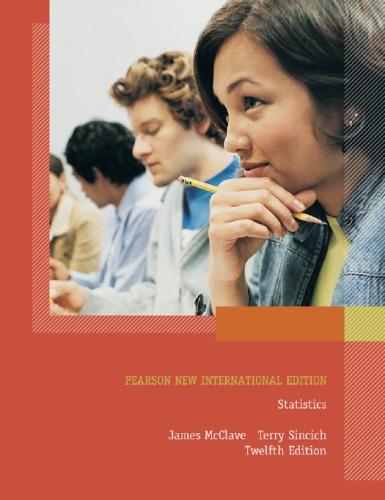153 IQs and The Bell Curve . In their controversial book The Bell Curve (Free Press, 1994),...
Question:
153 IQs and The Bell Curve . In their controversial book The Bell Curve (Free Press, 1994), Professors Richard J.
Herrnstein (a Harvard psychologist who died while the book was in production) and Charles Murray (a political scientist at MIT) explored, as the subtitle states, “intelligence and class structure in American life.” The Bell Curve employs statistical analyses heavily in an attempt to support the authors’ positions. Since the book’s publication, many expert statisticians have raised doubts about the authors’ statistical methods and the inferences drawn from them. (See, for example, “Wringing The Bell Curve : A cautionary tale about the relationships among race, genes, and IQ,” Chance , Summer 1995.) One of the many controversies sparked by the book is the authors’
tenet that level of intelligence (or lack thereof) is a cause of a wide range of intractable social problems, including constrained economic mobility. The measure of intelligence chosen by the authors is the well-known intelligent quotient (IQ). Numerous tests have been developed to measure IQ; Herrnstein and Murray use the Armed Forces Qualification Test (AFQT), originally designed to measure the cognitive ability of military recruits.
Psychologists traditionally treat IQ as a random variable having a normal distribution with mean m = 100 and standard deviation s = 15.
In their book, Herrnstein and Murray refer to five cognitive classes of people defined by percentiles of the normal distribution. Class I (“very bright”) consists of those with IQs above the 95th percentile; Class II
(“bright”) are those with IQs between the 75th and 95th percentiles; Class III (“normal”) includes IQs between the 25th and 75th percentiles; Class IV (“dull”) are those with IQs between the 5th and 25th percentiles; and Class V
(“very dull”) are IQs below the 5th percentile.
a. Assuming that the distribution of IQ is accurately represented by the normal curve, determine the proportion of people with IQs in each of the five cognitive classes defined by Herrnstein and Murray.
b. Although Herrnstein and Murray define the cognitive classes in terms of percentiles, they stress that IQ scores should be compared with z -scores, not percentiles. In other words, it is more informative to give the difference in z -scores for two IQ scores than it is to give the difference in percentiles. Do you agree?
c. Researchers have found that scores on many intelligence tests are decidedly nonnormal. Some distributions are skewed toward higher scores, others toward lower scores. How would the proportions in the five cognitive classes defined in part a differ for an IQ distribution that is skewed right? Skewed left?
Step by Step Answer:






